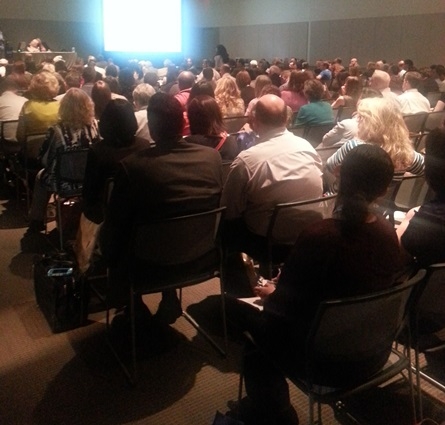
A Workshop Session, Challenges Facing the Next Generation of Risk Assessment, was presented on March 25 in conjunction with the 53rd Annual Meetig of the Society of Toxicology in Phoenix, Arizona. A summary of this session is provided below.
The audience packed the house for a lively and informative discussion on the current state of risk assessment, challenges we're facing, and potential solutions for the future.
As the world is filled with more technology, the complexity of exposures increases along with the need to consider more datasets and endpoints. So where are we now? The National Research Council's Board on Environmental Studies and Toxicology recently published several reports to be used as guidance for risk assessors. Thomas McKone of the University of California, Berkeley explained that these reports, which outline the driving factors changing the field of risk assessment today, cover important topics such as new technologies for toxicity testing (toxicogenomics and moving from animal to in vitro models), using an integrated approach that considers multiple stressors as opposed to discrete doses, and scaling up our thinking from individuals to populations and ecosystems. This led to a discussion on the concept of the "exposome" which illustrates the lifetime narrative of exposure events to multiple agents. Nancy Beck continued the discussion on the challenges of dose response assessment, which included topics such as low dose extrapolation, accounting for endogenous production of a toxicant, and nonlinear extrapolation. She suggested using a standardized approach to incorporate endogenous exposures in order to perform cumulative risk assessment.
In another presentation, Julie Goodman explained the weight of evidence approach and how it is used to weed through the plethora of available data today. She clearly outlined the step-by-step approach of the HB-WoE to critically reviewing studies for quality and relevance, integrating and evaluation evidence to include negative data and mode of action, and drawing conclusions even with uncertainties and data gaps. New technologies allow for the quick, high throughput screening of compounds thereby reducing the need for animal studies, but the drawbacks include interassay variability and adverse vs adaptive responses. To further this point, Paul S. Price explained that variability and uncertainty are inevitable in human dose response assessments. He brought up the interesting point that risk assessment in and of itself is an attempt to make decisions with sometimes considerable uncertainty.
The bottom line: the world we live in is becoming more complex and risk assessors are shifting their focus to broaden the considerations needed to make decisions with more uncertainty, but we're not too far gone. The US Environmental Protection Agency is taking a huge initiative to establish interoperability between the private, academic, and public sectors, and we hope to see a large repository of data that all groups can use for risk assessment. Overall, I'd say the future is bright for risk assessors!